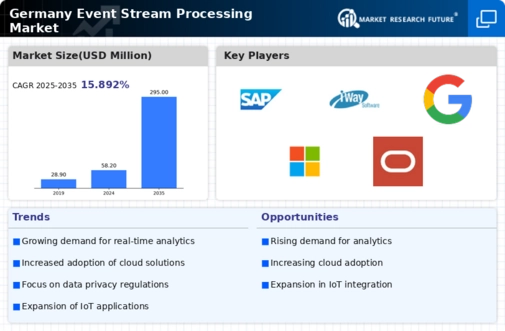Increased Focus on Cybersecurity
As cyber threats continue to evolve, the event stream-processing market in Germany is witnessing an increased focus on cybersecurity measures. Organizations are recognizing the importance of securing data streams and ensuring the integrity of their event processing systems. The event stream-processing market is likely to see a rise in demand for solutions that incorporate advanced security features, such as anomaly detection and real-time threat monitoring. In 2025, it is estimated that cybersecurity investments in this sector could exceed €300 million, reflecting the growing awareness of the need for robust security protocols. This trend not only protects sensitive information but also enhances the overall resilience of businesses operating within the market.
Advancements in Machine Learning and AI
Technological advancements in machine learning and artificial intelligence are reshaping the event stream-processing market in Germany. These innovations enable organizations to analyze vast amounts of data in real-time, enhancing predictive analytics capabilities. By integrating AI algorithms with event stream-processing frameworks, businesses can automate decision-making processes and improve operational efficiency. The event stream-processing market is likely to see increased investment in AI-driven solutions, as companies aim to leverage these technologies for competitive advantage. In 2025, it is estimated that AI-related investments in this sector could reach €500 million, underscoring the potential for growth and transformation within the market.
Growth of E-Commerce and Digital Services
The rapid expansion of e-commerce and digital services in Germany is a key driver for the event stream-processing market. As online transactions and digital interactions proliferate, businesses require efficient systems to manage and analyze the resulting data streams. The event stream-processing market is poised to benefit from this growth, as companies seek to optimize customer experiences and streamline operations. In 2025, the e-commerce sector is projected to reach €100 billion, creating a substantial demand for event stream-processing solutions that can handle high volumes of data in real-time. This trend underscores the necessity for businesses to invest in advanced technologies that facilitate seamless data processing and enhance operational agility.
Regulatory Compliance and Data Governance
The event stream-processing market in Germany is significantly influenced by regulatory compliance and data governance requirements. As organizations navigate complex data protection laws, such as the General Data Protection Regulation (GDPR), the need for robust event stream-processing solutions becomes critical. Companies are increasingly adopting technologies that ensure data integrity and compliance, thereby driving growth in the event stream-processing market. In 2025, it is anticipated that compliance-related investments will account for approximately 20% of the total market expenditure, highlighting the importance of aligning data processing practices with regulatory standards. This trend not only fosters trust among consumers but also enhances the overall credibility of businesses operating in the market.
Rising Demand for Real-Time Data Processing
The event stream-processing market in Germany experiences a notable surge in demand for real-time data processing solutions. As businesses increasingly rely on instantaneous insights to drive decision-making, the need for efficient event stream-processing technologies becomes paramount. In 2025, the market is projected to grow at a CAGR of approximately 15%, reflecting the urgency for organizations to harness real-time data. This trend is particularly evident in sectors such as finance and telecommunications, where timely information can significantly impact operational efficiency and customer satisfaction. The event stream-processing market is thus positioned to benefit from this growing demand, as companies seek to implement solutions that facilitate rapid data analysis and response.
















Leave a Comment